by Margaret Ransom
The California Equine Retirement Foundation (CERF), the second-ever OTTB retirement facility in the United States when founded in 1986 and once known as the gold standard for OTTB aftercare, had its 501c(3) non-profit status revoked by the state of California in 2017 and recently, many of the more than 70 pensioners residing on the property in San Jacinto, California, were found in desperate condition—a handful considered near starving while the shapes of the rest varying from extremely skinny to moderately underweight. Several exhibited the signs of severe rain rot on their backs and none of the horses appeared to have had their feet done in months.
Currently, CERF is operating as a 501c(2), a funding non-profit. This allows CERF to raise money to give to other non-profits but not keep any of the money for personal use.
Carrie Ard, who is identified on the sanctuary’s Facebook page as the Chief Operating Officer, is believed to be the main principal.
Rescue Efforts
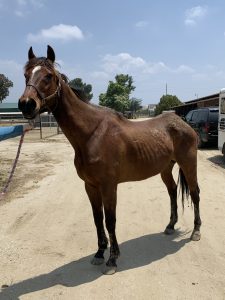
Delta Storm, 6/1/19. Photo: Jenny Earhart
Helen Meredith, founder and president of the United Pegasus Foundation (UPF), and Jenny Earhart, who runs Premier Equine Rehab (PER), have been working together over the past several weeks to deliver feed to the CERF property and move horses in the worst condition.
Overall, 19 horses have been removed from the CERF property so far, the most critical horses now at UPF and others to Earhart’s care, with more expected to be transferred over the next few days. Meredith and Earhart would ultimately like all the horses to be off the property.
The Clues
Meredith, who founded UPF in 1994 in her backyard after watching a news story about champion horses sold to feedlots when no longer useful for their owners, had been watching the CERF facility for a couple of years, but in November noticed that the hay barn located near the road never had many bales. She also heard from local feed stores that Ard only purchased hay bales a handful at a time. Meredith said she always maintained a friendly relationship with Ard and with concern growing decided several weeks ago it was time to pay a visit.
“I called and asked her if I could come down and say hello and pay a visit,” Meredith said. “And the first thing she said was to ask if she was in trouble, which I thought was strange. I told her no, but said that since the days were getting longer and we had more light I had more time after feeding to visit and catch up, and that I just wanted to say hello.
“So a few weeks ago I went down there and the first horse I saw in the barn was skin and bones. She told me the horse was ill and she kept me kind of up on a hill away from the other horses. I couldn’t really see them all, but I definitely saw some skinny ones. And as I expected I didn’t see any hay. That’s when I started to do some research and collect information to turn over to authorities.”
Aguas
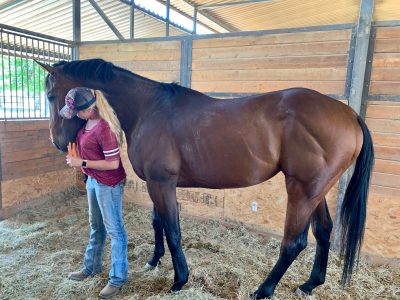
Jenny Earhart and Aguas, 5/31/19. Photo: Jenny Earhart
Earhart, who has been rehoming racehorses for a decade but set up shop as an official non-profit more than a year ago, said she first noticed the poor conditions of the horses on the CERF property in mid-May when she hauled one of her retirees, Aguas, to the organization for sanctuary.
The California-bred son of Stormy Jack had suffered a suspensory injury in his lone career start in March and while with time he could have been a trail horse or used for light riding, Earhart instead decided a permanent sanctuary was in his best interests. She previously had sent a handful of horses to CERF and at the time she made her way to the facility two weeks ago she had few concerns about their care.
“I could have waited and tried with Aguas, but his injury was serious enough that I knew keeping him sound in another discipline would be difficult, so I took him to CERF,” Earhart said. “I had donated a couple horses previously, along with financial support, so I never thought anything was wrong. But when I pulled in and looked around I was stunned.
“I didn’t want to leave Aguas there, but if I knew if I turned that trailer around I could not go back and every horse there would be in jeopardy. By leaving him there I would have a guaranteed way to get back in. I handed over a check for $450 that day and believed that he’d be fed, and I already had a game plan in mind. I didn’t want to leave him there but I knew that it would help the other horses in the long run and that he wouldn’t be there for long.”
Almost immediately after leaving the CERF property that day, Earhart reached out to Meredith, mostly because of her reputation as a top sanctuary, but also because a UPF property is located right around the corner from CERF and Ard had mentioned Meredith was her friend. Meredith shared her recent experience and history with CERF and the women decided to team up and get the horses safe.
“Initially, I expressed my concerns [with Helen Meredith] and was relieved to hear that she was well aware of the situation,” Earhart said. “She told me animal control had been called three times, but didn’t do anything so that’s when we together decided to team up and do whatever we had to do to get the horses fed and then ultimately off the property.”
Last weekend, the two women delivered some much-needed hay and feed to CERF and started removing the horses who are in the worst shape. Ard, they said, has become somewhat difficult and has denied them access to certain areas of the property, but otherwise has allowed them to help. More are being removed this weekend with arrangements being made for the rest.
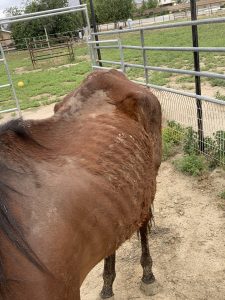
Retiree at CERF, 5/24/19. Photo: Jenny Earhart
“There were about five who were a solid 1 on the Henneke scale,” Earhart said. “Helen took the worse cases and I took some of the others, as well as Aguas, and we’ve been figuring out what to do next. [Carrie Ard] said her vet, Dr. Cobb, had seen the horses but when I contacted him this week he said he hadn’t been called out to the property in months. And none of the horses have had their feet done in at least that long.”
Origins and the $2 Million Question
Grace Belcuore opened CERF’s doors in 1986 to provide charitable assistance to former race and performance horses upon the conclusion of their careers.
For the better part of 25 years, dozens of horses were sent to CERF to be rehomed or retired, their lifetime safety virtually guaranteed. Though the original CERF horses more than 30 years ago were boarded, eventually the rescue set up shop on a property Belcuore purchased in Winchester, CA, which she leased back to CERF during her tenure.
However, in 2014 Belcuore was ejected by her board, citing her age and health concerns, and replaced by then-board member Ard, who has served as the organization’s COO and has been in charge of the organization since.
The ousting of Belcuore was somewhat controversial due to her status as the founder and operator of one of the country’s top OTTB retirement sanctuaries and reputation for outstanding care. After her removal, CERF and Ard sued Belcuore in 2014 to extend the sanctuary’s lease on the Winchester property to 99 years and also for $100,000 in alleged misappropriation of assets. It turned out an extension on the lease wouldn’t be necessary because in 2016, CERF received a $2.4 million donation allowing it to purchase the property it currently sits on in San Jacinto.
“In about April of 2016, (CERF) bought the property and paid $1.4 million for it,” Meredith said. “I know because I received the same amount at the same time. So they paid for the property and there was a million dollars left, but what we all need to know is where is that $1 million and where did it go if it’s obviously not being used for the horses?”
At the time the property was purchased, CERF’s non-profit status was listed as suspended, according to documents on the California state attorney general’s website, which opens even more doors to concerns about who owns the property and where all the money went. And because of the uncertainty, Meredith and Earhart agreed that transferring all of the horses to their care, custody and control is in their best interests as both have OTTB retirement experience and both are currently certified by the state of California as non-profits in good standing.
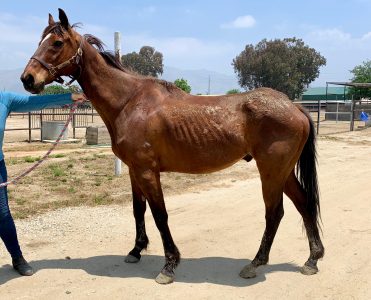
Delta Storm, 6/1/19. Photo: Jenny Earhart
Meredith has been in touch with the attorney general regarding the alleged financial malfeasance and also filed additional complaints with the county sheriff and animal control, who have been out to UPF to photograph and document the thinnest horses. She also explained how the situation was allowed to continue and become so dire without detection for so long.
For the past couple of years Ard has not applied for yearly grants from the accrediting organizations who would normally be responsible for spot checks, such as the Thoroughbred Aftercare Alliance (TAA) and the California Retirement Management Account (CARMA). Without grants and accreditation, no organization has the ability to inspect the properties.
“She had received a huge grant and had $1 million left over to care for the horses, so the TAA and CARMA had no reason to think anything untoward was going on,” Meredith said.
What Will Happen Now?
While Meredith and Earhart would have preferred to keep the situation as quiet as possible and move horses to safety without attention, they also realize that people who might still want to donate horses and money to CERF need to know. Also with the number of horses who will be either absorbed into Meredith’s UPF or re-homed by Earhart, the women acknowledge they will need some financial help.
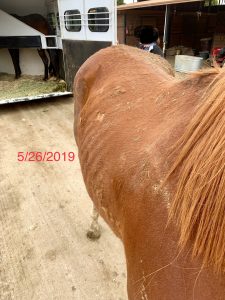
Horse at CERF. Photo: Jenny Earhart
“I kept the property up in Tehachapi so between the two properties I have plenty of room for the horses,” Meredith said. “I can move a bunch to the San Jacinto property right away, but it will be a bit squished while I move horses back up to Tehachapi.
“I plan financially three or four years in advance for the horses I have so using those funds for the CERF horses certainly takes away from that. I had to buy a bunch of pasture feeders at $360 each and will certainly need more. I don’t have a lot of resources up in Tehachapi since it’s been mostly closed and I’ll have to hire some new help and get the insurance going. It’s a big expense, but I’m absolutely fine to do it to help the horses. Right now we don’t want them going here and there and everywhere, and between the two ranches and with Jenny we have enough room.
“They really shouldn’t stay on the CERF property since it’s really not a good location for a sanctuary, it’s on a flood plane and it’s not clear what will happen to it now. The property should be sold and all assets transferred to other non-profits, as dictated by the CERF bylaws, but that’s getting way ahead of where we are now with the horses.”
Earhart said that despite the sadness of situation, she’s most proud that the two rescues have been able to show the world how easy it is to work together. With so much negativity going on between equine non-profits as they all fight for every charitable dollar, she hopes that others can learn to work together when in crisis. She also said she’s grateful to Aguas, who inadvertently pulled the cloak back on the awful conditions at CERF.
“I really do owe him so much,” Earhard said of the gelding. “He is one of the main reasons we’ll be able to get all of these horses safe. I hated leaving him, but he will never, ever be left again. He’s doing so well today and I am so grateful to have him. He will never know how important he was to this whole situation.”
If you want to help Meredith and Earhart, tax-deductible donations can be made to both organizations via PayPal.
United Pegasus Foundation: upfgiftshop@yahoo.com
Premiere Equine Rehab: PremierEquineRehab@gmail.com (also Venmo @premiereequinerehab)
Ard could not be reached for comment.
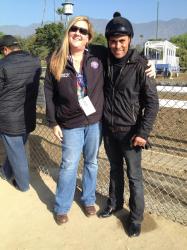
California native and lifelong horsewoman Margaret Ransom is a graduate of the University of Arizona’s Race Track Industry Program. She got her start in racing working in the publicity departments at Calder Race Course and Hialeah Park, as well as in the racing office at Gulfstream Park in South Florida. She then spent six years in Lexington, KY, at BRISnet.com, where she helped create and develop the company’s popular newsletters: Handicapper’s Edge and Bloodstock Journal.After returning to California, she served six years as the Southern California news correspondent for BloodHorse, assisted in the publicity department at Santa Anita Park and was a contributor to many other racing publications, including HorsePlayer Magazine and Trainer Magazine. She then spent seven years at HRTV and HRTV.com in various roles as researcher, programming assistant, producer and social media and marketing manager.
She has also walked hots and groomed runners, worked the elite sales in Kentucky for top-class consignors and volunteers for several racehorse retirement organizations, including CARMA.In 2016, Margaret was the recipient of the prestigious Stanley Bergstein Writing Award, sponsored by Team Valor, and was an Eclipse Award honorable mention for her story, “The Shocking Untold Story of Maria Borell,” which appeared on USRacing.com. The article and subsequent stories helped save 43 abandoned and neglected Thoroughbreds in Kentucky and also helped create a new animal welfare law in Kentucky known as the “Borell Law.”Margaret’s very first Breeders’ Cup was at Hollywood Park in 1984 and she has attended more than half of the Breeders’ Cups since. She counts Holy Bull and Arrogate as her favorite horses of all time.She lives in Robinson, Texas, with her longtime beau, Tony. She is the executive director of the 501(c)(3) non-profit horse rescue, The Bridge Sanctuary.


